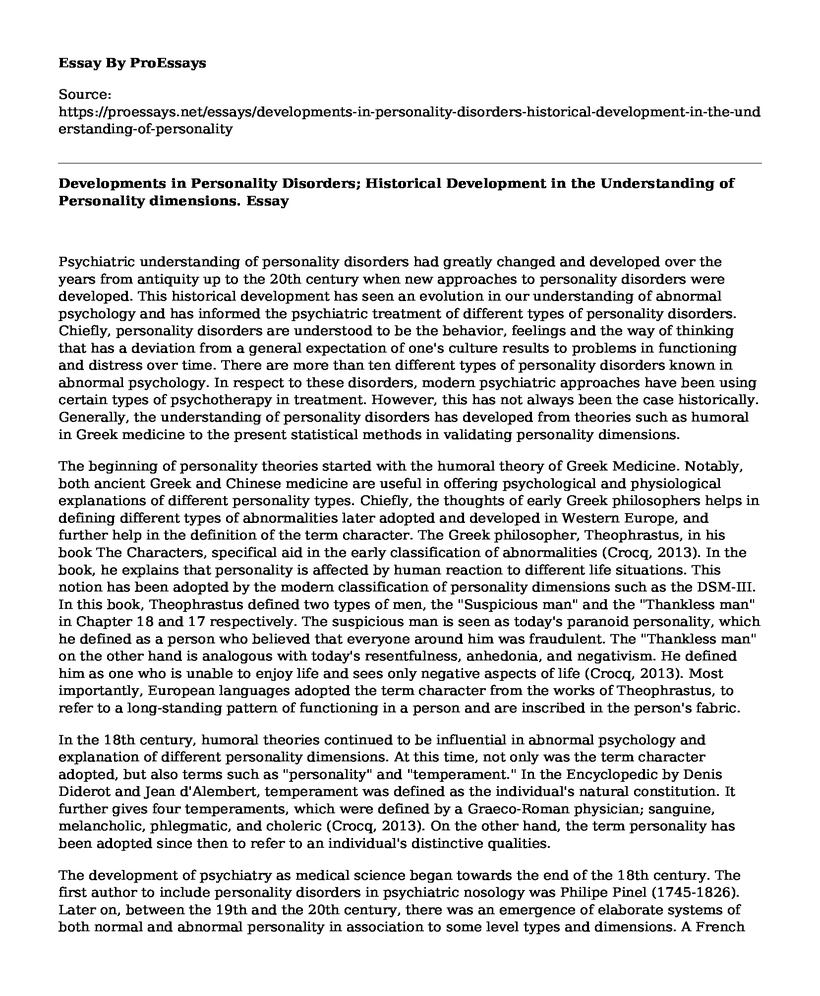Psychiatric understanding of personality disorders had greatly changed and developed over the years from antiquity up to the 20th century when new approaches to personality disorders were developed. This historical development has seen an evolution in our understanding of abnormal psychology and has informed the psychiatric treatment of different types of personality disorders. Chiefly, personality disorders are understood to be the behavior, feelings and the way of thinking that has a deviation from a general expectation of one's culture results to problems in functioning and distress over time. There are more than ten different types of personality disorders known in abnormal psychology. In respect to these disorders, modern psychiatric approaches have been using certain types of psychotherapy in treatment. However, this has not always been the case historically. Generally, the understanding of personality disorders has developed from theories such as humoral in Greek medicine to the present statistical methods in validating personality dimensions.
The beginning of personality theories started with the humoral theory of Greek Medicine. Notably, both ancient Greek and Chinese medicine are useful in offering psychological and physiological explanations of different personality types. Chiefly, the thoughts of early Greek philosophers helps in defining different types of abnormalities later adopted and developed in Western Europe, and further help in the definition of the term character. The Greek philosopher, Theophrastus, in his book The Characters, specifical aid in the early classification of abnormalities (Crocq, 2013). In the book, he explains that personality is affected by human reaction to different life situations. This notion has been adopted by the modern classification of personality dimensions such as the DSM-III. In this book, Theophrastus defined two types of men, the "Suspicious man" and the "Thankless man" in Chapter 18 and 17 respectively. The suspicious man is seen as today's paranoid personality, which he defined as a person who believed that everyone around him was fraudulent. The "Thankless man" on the other hand is analogous with today's resentfulness, anhedonia, and negativism. He defined him as one who is unable to enjoy life and sees only negative aspects of life (Crocq, 2013). Most importantly, European languages adopted the term character from the works of Theophrastus, to refer to a long-standing pattern of functioning in a person and are inscribed in the person's fabric.
In the 18th century, humoral theories continued to be influential in abnormal psychology and explanation of different personality dimensions. At this time, not only was the term character adopted, but also terms such as "personality" and "temperament." In the Encyclopedic by Denis Diderot and Jean d'Alembert, temperament was defined as the individual's natural constitution. It further gives four temperaments, which were defined by a Graeco-Roman physician; sanguine, melancholic, phlegmatic, and choleric (Crocq, 2013). On the other hand, the term personality has been adopted since then to refer to an individual's distinctive qualities.
The development of psychiatry as medical science began towards the end of the 18th century. The first author to include personality disorders in psychiatric nosology was Philipe Pinel (1745-1826). Later on, between the 19th and the 20th century, there was an emergence of elaborate systems of both normal and abnormal personality in association to some level types and dimensions. A French psychologist, Theodule Ribot (1839-1916) apart from coining the term anhedonia for the first time, gave different subtypes of normal personality; sensitive and emotional personality (introverted) , the active personality (extroverted), and the apathetic, with little excitation and reaction (Crocq, 2013). These dimensions were further subdivided into other dimensions. In contemporary psychiatry, however, are based on statistical analysis, pioneered by Raymond Bernard Cattell (1905-1998). He believed that personality should be based on measures to discover personality statistically. Consequently, the most successful dimensional model in the description of personality has been the DSM-T model or the five-factor model. The model has five personality dimensions; negative effect, detachment, antagonism, disinhibition, and psychoticism (HOERMANN, ZUPANICK, & DOMBECK, n.d.). This model continues to be modified in present psychiatry approaches.
In conclusion, the long history of the DSM classification of personality disorders has shaped the psychiatric and psychological understanding of abnormal psychology. From the early humoral theories in Greek medicine to the present statistical measurement of personality, terms such as character, temperament, and personality has been defined, and as a result, different dimensions of personality has been defined. Consequently, personality disorders have been categorized into different types.
References
Crocq, M. A. (2013). Milestones in the history of personality disorders. Dialogues in clinical neuroscience, 15(2), 147-53. Retrieved from https://www.ncbi.nlm.nih.gov/pmc/articles/PMC3811086/
HOERMANN, S., ZUPANICK, C. E., & DOMBECK, M. (n.d.). Alternative Diagnostic Models for Personality Disorders Continued. Retrieved February 21, 2019, from https://www.mentalhelp.net/articles/alternative-diagnostic-models-for-personality-disorders-continued/
Cite this page
Developments in Personality Disorders; Historical Development in the Understanding of Personality dimensions.. (2022, Nov 23). Retrieved from https://proessays.net/essays/developments-in-personality-disorders-historical-development-in-the-understanding-of-personality
If you are the original author of this essay and no longer wish to have it published on the ProEssays website, please click below to request its removal:
- Essay on Politics of Feminism and Democracy
- Big-Five and Callous-Unemotional Traits in Preschoolers Essay Example
- Essay Example on Foster Care Diversity: Examining the Unique Experiences of Foster Children
- Essay Sample on Liberalism: Protecting People's Interests in Politics
- Essay Example on Pedro Hernandez vs Texas: A 1951 Human Rights Case
- Attractive Relationship Alt. Impacts Early Cognition & Self-Protection - Essay Sample
- Essay Example on Probation Officers: Managing Crime and Punishment







